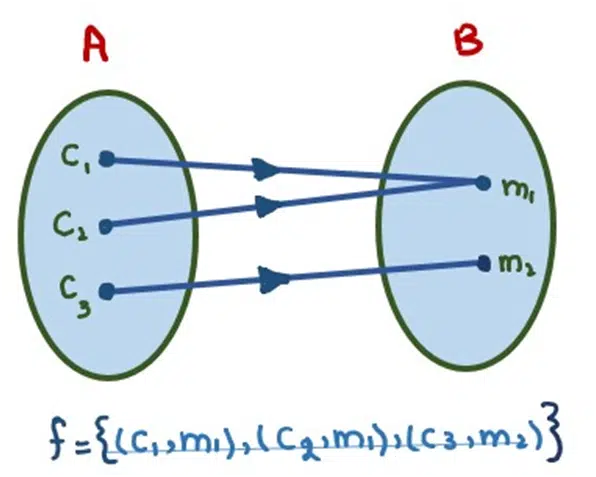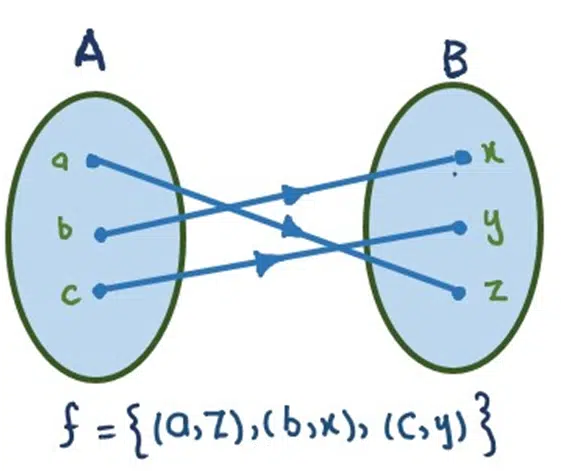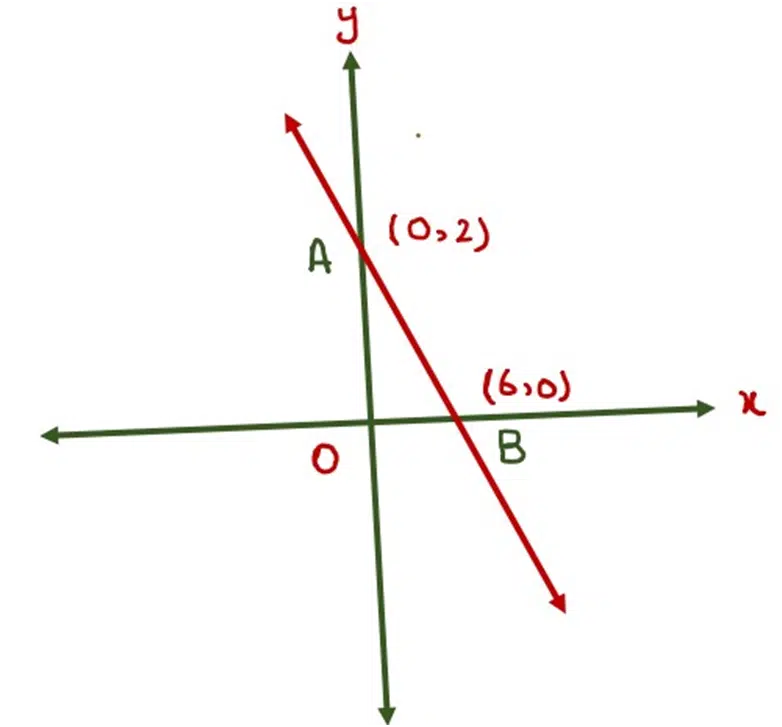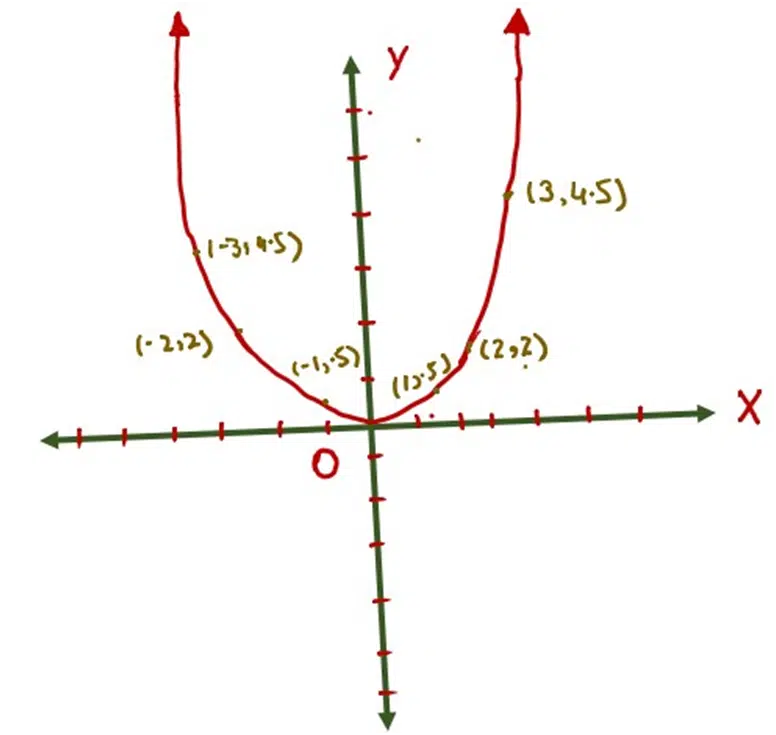Functions-Types of Function
What is Function in Math?
A function is a rule that relates each element of a set X with exactly one element of set Y. It also is defined as the relationship between one variable (the independent variable) and another variable (the dependent variable).
- “…each element…” means that every element in set X is associated with or connected to at least one element in set Y.
(Note that there may be some elements in Y that remain unrelated to any elements in X, and that’s acceptable.)
- “…exactly one…” means that a function is single-valued means that there is only one output of X.
The formula for the area of a circle, A = πr2, gives the dependent variable A (the area) as a function of the independent variable r (the radius).
Functions are fundamental building blocks in mathematics, and they have various applications in science, engineering, and computer science.
Representation of Functions
Let f be a function from X to Y is represented as
f :X Y
read as “y is a function of x”.
Functions are generally represented as y = f(x).
Let, f(x) = x3.
It is said as f of x is equal to x cube.
Functions can also be represented by g(), t(),… etc.
The domain of a Function
The domain of a function is the set of all possible inputs for the function.
The codomain of a Function
The codomain or set of destinations of a function is the set into which all of the output of the function is constrained to fall.
Range of a Function
The range of a function refers to all the possible outputs of a function.
Example:
Let f(x) = x2. Find the domain and range of f.
Solution:
f(x) is defined for every real number x. Further for every real number x, f(x) = x2 is a non-negative real number.
So, Domain f = Set of all real numbers.
Range f = Set of all non-negative real numbers.
Vertical line test
A vertical line test is used to determine whether a curve is a function or not. If any curve cuts a vertical line at more than one point, then the curve is not a function.
Types of Function
There are various types of functions given as:
- One-to-one Function (Injective Function)
- Onto Function (Surjective Function)
- One to One and Onto function (bijective function)
- Into Function
- Polynomial Function
- Linear Function
- Constant Function
- Identity Function
- Quadratic Function
- Rational Function
- Algebraic Functions
- Cubic Function
- Even and Odd Function
- Periodic Function
- Composite Function
Into Function
If a function f: A → B is such that Ran f ⊂ B i.e., Ran f ≠ B, then f is said to be a function from A into B.
Fig f is a function. But Ran f ≠ B.
Therefore, f is a function from A to B.

Onto (Surjective) function
If a function f: A→B is such that
Ran f = B i.e., every element of B is the image of some elements of A, then f is called an onto function or a surjective function.

One to One and Into (Injective) function
If a function f from A into B is such that second elements of no two of its ordered pairs are equal, then it is called an injective (1 – 1, and into) function. The function shown in Fig is such a function.

One to One and Onto function (bijective function)
If f is a function from A onto B such that the second element of no two of its ordered pairs are the same, then ƒ is said to be (1-1) function from A onto B. Such a function is also called a (1-1) Correspondence between A and B. It is
also called a bijective function. Fig shows a (1-1) correspondence between the sets A and B.
(a, z), (b, x) and (c, y) are the pairs of corresponding elements i.e., in this case
f= {(a, z), (b, x). (c, y)} which is a bijective function or (1-1) correspondence
between the sets A and B.

Polynomial Function
A polynomial function is a function that is defined by a polynomial expression in one or more variables. It consists of non-negative integer powers of the variable(s) multiplied by constants.
Example: f(x) = 3x^2 + 2x – 1 is a polynomial function of degree 2.
Linear Function
A linear function is a polynomial function of degree 1, and its graph is a straight line. It has the form f(x) = mx + b, where m is the slope and b is the y-intercept.
Example: f(x) = 2x + 3 is a linear function.
Constant Function
A constant function is a function that always returns the same constant value, regardless of the input.
Example: f(x) = 5 is a constant function as it always gives the output 5.
Identity Function
The identity function is a function that returns the same value as its input. The domain and codomain are the same for the identity function.
Example: f(x) = x is the identity function.
Quadratic Function
A quadratic function is a polynomial function of degree 2. Its graph is a parabola.
Example: f(x) = x^2 + 2x – 3 is a quadratic function.
Example
A rough sketch of the functions
i) ((x, y) | 3x+y = 2)
ii) ((x, y) l y= ½ x2)
Solution
i) The equation defining the function is 3x + y = 2
⇒ y = -3x + 2
We know that this equation, being linear, represents a straight line. Therefore, for drawing its sketch or graph only two of its points are sufficient.
When
x=0, y = 2.
y = 0, x = 2/3 = 0.6 nearly.
So two points on the line are A (0, 2) and B = (0.6, 0).
Joining A and B and producing the AB bar in both
directions, we obtain the line AB i.e., the graph of the given function.

ii) The equation defining the function is
y =1/2 x2.

Corresponding to the values {…,-3, -2, -1, 0, 1, +2, +3} of x, values of y are 0, .5, 2, 4.5, …
We plot the points
(0, 0), (± 1, .5), (± 2, 2),(± 3, 4.5),… Joining them by means of a smooth
curve and extending it upwards we get the required graph. We notice that:
i) The entire graph lies above the x-axis.
ii) Two equal and opposite values of x corresponding to every value of y (but not vice versa).
iii) 0 As x increases (numerically) y increases and there is no end to their increase. Thus the graph goes infinitely upwards.
Rational Function
A rational function is a function that can be represented as the ratio of two polynomial functions.
Example: f(x) = (3x^2 + 2x – 1) / (x – 2) is a rational function.
Algebraic Functions
An algebraic function is a function that can be constructed using algebraic operations (addition, subtraction, multiplication, division) and applying roots and powers to the variable(s).
Example: f(x) = √(x^3) + 2x is an algebraic function.
Cubic Function
A cubic function is a polynomial function of degree 3. Its graph often has an S-shape.
Example: f(x) = x^3 – 4x^2 + 2x + 1 is a cubic function.
Even and Odd Function
An even function is a function that satisfies f(x) = f(-x) for all x in its domain.
An odd function satisfies f(x) = -f(-x) for all x in its domain.
Example of an even function: f(x) = x^2
Example of an odd function: f(x) = x^3
Periodic Function
A periodic function is a function that repeats its values at regular intervals. There exists a positive constant ‘P’ such that f(x + P) = f(x) for all x in the domain.
Example: f(x) = sin(x) is a periodic function with a period of 2π.
Composite Function
A composite function is formed by applying one function to the output of another function.
Example: If f(x) = 2x and g(x) = x + 3, then the composite function (g ∘ f)(x) = g(f(x)) = g(2x) = 2x + 3.
Set-Builder Notation for a function
We know that sub-builder notation is more
suitable for infinite sets. So is the case in respect of a function comprising an infinite
number of ordered pairs. Consider, for instance, the function
f = {(1,1), (2, 4), (3, 9), (4, 16)….}
Dom f= {1, 2, 3, 4,…}.
Ran f = {1,4,9, 16, …}
This function may be written as:
f = {(x, y) l y =r², x ∈ N}
For the sake of brevity this function may be written as:
f = function defined by the equation y=x2, x ∈ N.
Or, to be still more brief: The function, x2, x ∈ N.
In algebra and Calculus the domain of most functions is R and if evident from the context it is, generally, omitted.
The inverse of a function
If a relation or a function is given in the tabular form i.e., as a set of ordered pairs, its inverse is obtained by interchanging the components of each ordered pair.
The inverse of r and f is denoted r-1 and f-1 respectively.
If r or f are given in set-builder notation the inverse of each is obtained by interchanging x and y in the defining equation. The inverse of a function may or may not be a function.
The inverse of the linear function
{(x, y) y= mx+ c) is ((x, y) l x= my+ c) which is also a linear function.
Briefly, we may say that the inverse of a line is a line.
The line y= x is clearly self-inverse. The function defined by this equation i.e., the function (x, y) | y= x) is called the identity function.
Example
Find the inverse of
i) {(1, 1), (2, 4). (3, 9), (4, 16), x ∈ Z+}
ii) {(x, y) l y= 2x+ 3, x ∈ R)
Which of these are functions.
Solution
i) The inverse is:
{(2, 1), (4, 2), (9,3), (16, 4)…}
This is also a function.
Note: Remember that the equation
y= √x, x ≥ 0
defines a function but the equation y2 = x, x ≥ 0 does not define a function.
The function defined by the equation.
y= √x, x ≥ 0
is called the square root function.
The equation y2 = x ⇒ y = ±√x
Therefore, the equation y= x (x ≥ 0) may be regarded as defining the union of the functions defined by
y = √x, x ≥ 0 and y = -√x, x ≥ 0.
ii) The given function is a linear function.
Its inverse is: {(x, y) | x= 2y + 3}
Which is also a linear function.
Points (0, 3), (-1.5, 0) lie on the given line and points (3, 0), (0, -1.5) lie on its inverse.







Leave a Reply